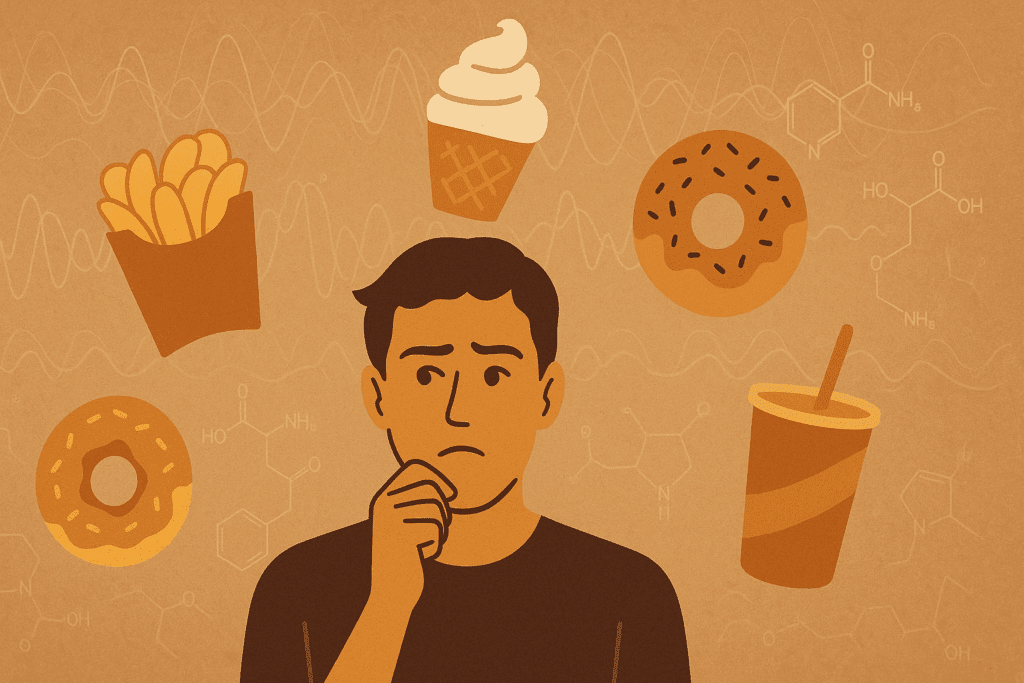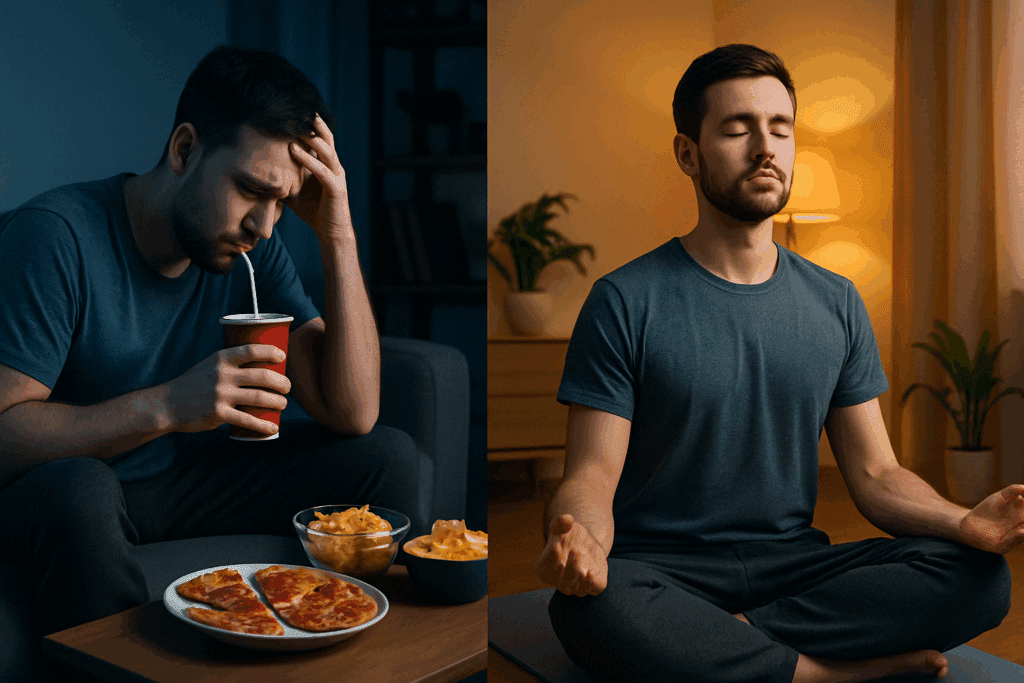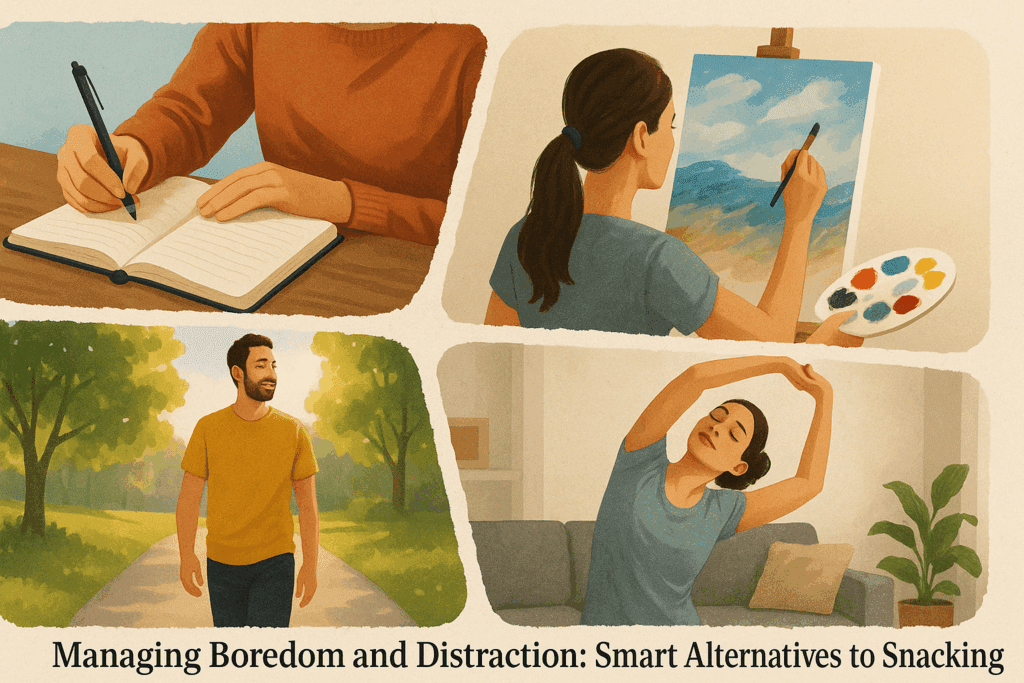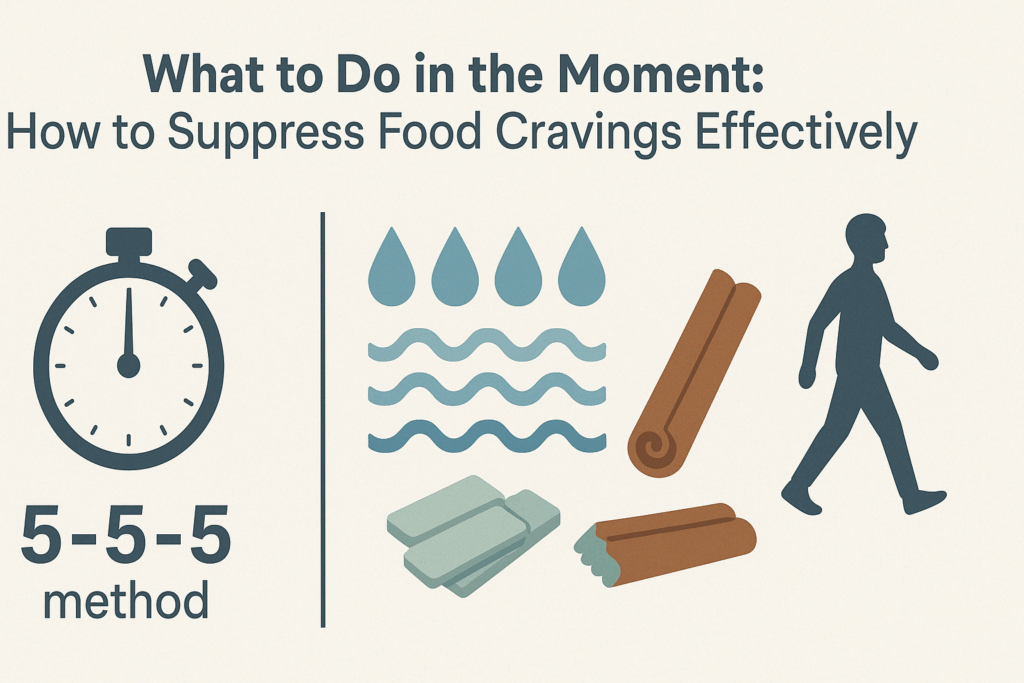Why We Crave: The Hidden Science Behind Food Urges
Food cravings are deeply rooted in human biology and psychology, often arising without any connection to true physical hunger. When you’re constantly craving something—especially high-calorie, processed foods—it may seem like a lack of discipline. But science tells a more complex story. Cravings result from a combination of hormonal signals, neurological patterns, environmental cues, and emotional triggers. Ghrelin, the hormone responsible for hunger, rises before meals and falls after eating. However, stress, poor sleep, and blood sugar fluctuations can disrupt this process, leaving people vulnerable to urges even after a full meal.
In our modern environment, where ultra-processed, hyper-palatable foods are everywhere, cravings are essentially engineered into our daily lives. Food manufacturers intentionally design products to override natural satiety signals, making it difficult to stop eating when not hungry. This disconnect between what our body needs and what our brain desires can lead to patterns of emotional eating and disordered food behaviors. Learning how to control food cravings starts with understanding how modern life interferes with ancient biological survival mechanisms.
By identifying what drives your cravings—be it hormonal imbalances, chronic stress, or environmental triggers—you gain clarity and control. Acknowledging these roots empowers you to change your response. Once you recognize that the urge to snack isn’t always based on hunger, it becomes easier to adopt strategies for how to avoid cravings and create mindful eating routines.
You may also like: Why Am I Craving Sweets All of a Sudden? Expert-Backed Reasons and How to Stop Sugar Cravings Naturally

Emotional Eating and Stress: How They Influence Cravings
Emotions are one of the strongest forces behind food cravings. When you’re overwhelmed, anxious, or even bored, food often becomes a quick fix—a way to self-soothe and regulate emotions in the short term. The release of dopamine after eating comfort food reinforces this behavior, making it more likely to happen again in similar emotional states. That’s why learning how to stop cravings tied to mood is essential for long-term craving control.
Stress, in particular, triggers a physiological cascade that directly impacts your appetite. Elevated cortisol levels drive cravings for sugar, salt, and fat—fast sources of energy the body thinks it needs in times of crisis. However, most modern stressors are psychological, not physical. We’re not running from predators but sitting in traffic, managing deadlines, or processing emotional challenges. Still, the body reacts the same way, leading to increased eating even when not physically hungry.
One effective technique to combat cravings triggered by emotions is mindfulness. By practicing mindfulness meditation or breathwork when a craving hits, you shift your awareness away from the automatic response to eat and back into the present moment. This mental pause creates a crucial space where you can decide how to respond. Over time, these strategies reduce the intensity of emotional cravings and reinforce your ability to manage discomfort without food.

How to Stop Eating When Not Hungry: Recognizing Internal Signals
A crucial skill in reducing food cravings is learning to recognize and respond to your body’s true hunger cues. Physical hunger builds gradually and includes signs like stomach rumbling, light-headedness, or low energy. Emotional hunger, by contrast, tends to arise suddenly and is often specific, such as craving cookies, chips, or ice cream. Distinguishing between the two helps you stop eating when not hungry and prevents mindless snacking.
Developing interoceptive awareness—the ability to tune into your internal physical sensations—can dramatically enhance craving control. Mindful eating is a practical way to cultivate this skill. By eating slowly, savoring each bite, and paying attention to the texture, aroma, and taste of your food, you allow your brain to register satisfaction and fullness more clearly.
Using a hunger-fullness scale can also be helpful. Before and after each meal, ask yourself where you fall on a scale from 1 (extremely hungry) to 10 (overstuffed). Ideally, you should eat at 3 or 4 and stop at 6 or 7. This structured, intuitive approach helps reestablish trust between your mind and body. Over time, you’ll learn how to reduce cravings by responding only to real hunger, not habit, boredom, or emotional impulse.

Nutritional Tools: Foods That Help Reduce Cravings
What you eat directly affects how often you crave unhealthy snacks. Diets high in sugar and refined carbs often cause rapid spikes and crashes in blood glucose levels. These fluctuations can leave you constantly craving more food, especially sweets or starches. Choosing balanced meals with high-quality nutrients is one of the most effective ways to reduce cravings naturally.
Protein plays a central role in satiety. Including sources like lentils, tofu, tempeh, beans, and quinoa can help stabilize blood sugar and prolong fullness after meals. Fiber is another critical component; it slows digestion and improves gut health, which is closely linked to appetite regulation. Vegetables, fruits, legumes, and whole grains offer the type of fiber that helps suppress food cravings by promoting steady energy levels.
Healthy fats also contribute to long-term satiety and hormone balance. Avocados, nuts, seeds, and olive oil help keep hunger at bay without triggering spikes in insulin or dopamine-driven reward responses. These foods to reduce cravings not only keep you satisfied but also support your overall health goals. Eating in a way that balances macronutrients allows you to curb cravings while feeling nourished and energized.

How to Trick Your Brain Into Avoiding Cravings
The brain is an incredibly adaptable organ, and you can retrain it with consistent strategies that interrupt unhelpful patterns. One proven method involves reshaping your environment. Keep tempting foods out of reach—or better yet, out of the house. Stock your kitchen with wholesome, convenient options like fresh fruit, roasted chickpeas, or unsweetened yogurt. This subtle shift makes healthy choices the path of least resistance, helping you trick your brain into avoiding cravings.
Building consistent routines is another powerful tool. Eating meals at roughly the same times each day, sitting at the table, and minimizing screen time during meals helps reinforce structured, mindful eating. These rituals ground your eating behaviors in intention and reduce reactive or emotional choices. They also teach your brain that food is for nourishment—not for entertainment or emotional relief.
Visualization and mental rehearsal also work well. When you feel a craving coming on, imagine yourself making a different choice, like going for a walk or preparing a nutritious snack. Mentally practicing these alternatives primes your brain to act on them in real life. These techniques represent smart ways to trick your brain into avoiding cravings, especially when emotional or environmental cues are involved.

Managing Boredom and Distraction: Smart Alternatives to Snacking
Boredom is one of the most underestimated triggers for snacking. When you’re not mentally stimulated, your brain often seeks reward through food. Learning how to distract yourself from eating in these moments is crucial. The key is to have a go-to list of engaging activities that serve as non-food rewards. These can include calling a friend, working on a hobby, organizing a small space, or stepping outside for fresh air.
Physical movement can be especially effective. Even five minutes of stretching, dancing, or walking can elevate mood and reduce the emotional tension that drives cravings. Pairing these activities with self-affirmation or mindful reflection further disrupts the reward cycle linked to food. You’re not just avoiding snacks—you’re actively choosing to nurture your well-being.
Changing your environment also helps. If you associate a certain room or time of day with snacking, switch things up. Move to a different space or rearrange your schedule to include fulfilling breaks. Over time, your brain will begin to associate those moments with new, healthier routines. These are highly effective strategies when figuring out how to stop eating when not hungry due to sheer habit or boredom.
Resetting Your Taste Buds: How to Stop Craving Junk Food
Cravings for junk food are often a matter of habit and desensitized taste buds. The more you eat foods rich in sugar, salt, and fat, the more your brain comes to expect them—and the less satisfying natural foods seem. But the good news is that you can reset your palate. By gradually reducing your intake of processed snacks and focusing on whole foods, your taste sensitivity will improve.
Start by making small substitutions. Replace soda with sparkling water infused with citrus or berries. Swap out chips for roasted vegetables with seasoning. Over time, these changes allow your brain and body to adapt to more subtle, natural flavors. You’ll begin to crave foods that nourish you, not just those that provide a quick dopamine spike.
Mindful tasting also helps recalibrate your preferences. Instead of eating on autopilot, slow down and fully engage your senses. Notice the sweetness in a fresh strawberry or the richness of roasted nuts. This practice not only makes meals more enjoyable but also trains your brain to appreciate healthier foods, making it easier to stop craving junk food altogether.

What to Do in the Moment: How to Suppress Food Cravings Effectively
In the heat of the moment, cravings can feel overwhelming. But there are evidence-based techniques to help suppress food cravings before they lead to impulsive eating. One of the most effective is the 5-5-5 strategy: take five deep breaths, wait five minutes, and drink five ounces of water. This brief pause can help reset your nervous system and reduce urgency.
Engaging your senses with non-food stimuli can also short-circuit a craving. Chew minty gum, sniff a calming essential oil, or suck on a cinnamon stick—these alternatives create enough sensory input to satisfy your brain’s desire for stimulation without triggering a caloric response. They’re small but powerful tools when figuring out how to combat cravings quickly.
Physical activity, even if minimal, creates a natural dopamine release. A few jumping jacks, a walk around the block, or a few minutes of yoga can drastically shift your mindset and reduce craving intensity. Practicing these techniques regularly gives you a reliable toolkit for how to suppress food cravings whenever they appear.
Building a Resilient Mindset: Long-Term Craving Control
Achieving long-term craving control isn’t about perfection—it’s about consistency, curiosity, and compassion. Rather than judging yourself for having cravings, view them as opportunities to learn more about your body’s needs. Journaling your eating habits, emotional states, and hunger levels over time can reveal patterns that empower you to make more intentional decisions.
Cognitive behavioral strategies are also valuable for reinforcing lasting change. Challenge unhelpful thoughts like “I need this snack to feel better” and replace them with statements rooted in truth: “I can feel better by going outside or calling a friend.” These mental shifts support behavior change from the inside out.
Over time, small changes become ingrained habits. The more often you choose a mindful alternative to impulsive eating, the stronger your neural pathways become. This is how to control food cravings in the long run—by consistently showing your brain that it has other options, and that you’re in charge.
Frequently Asked Questions: Craving Control and Mindful Eating Strategies
1. Why do some people experience stronger cravings than others, and how can they manage them effectively?
Craving intensity can vary based on genetics, hormone levels, sleep quality, stress resilience, and past eating habits. People who are constantly craving sugary or salty foods often have heightened dopamine sensitivity, making them more reactive to food-related stimuli. If you’re prone to intense cravings, it’s helpful to regulate blood sugar through balanced meals and sleep optimization, which supports hormonal equilibrium. One of the most effective long-term methods for how to reduce cravings is to focus on consistent meal timing paired with nutrient-dense foods that support satiety. These strategies, alongside learning how to avoid cravings triggered by stress or habit, can create a more stable internal environment, making it easier to control food cravings day to day.
2. How can people retrain their brain to crave healthy foods instead of junk?
Reconditioning your palate and reward system takes time, but it’s completely possible with sustained exposure to whole, minimally processed foods. Begin by gradually phasing out ultra-processed options rather than cutting them out all at once. Over time, your brain recalibrates its pleasure responses—what once felt bland, like roasted vegetables or plain fruit, can become satisfying. One of the most impactful ways to trick your brain into avoiding cravings for junk food is to replace reward-based eating with other forms of gratification like creative projects, nature walks, or social connection. Building these alternative feedback loops not only helps stop craving junk food but also reshapes how your brain associates pleasure with nourishment.
3. What are some overlooked psychological techniques for suppressing food cravings?
While mindfulness and journaling are common, advanced psychological tools like implementation intentions and “if-then” planning are particularly effective. For example, telling yourself, “If I feel the urge to snack while bored, then I will go for a five-minute walk,” creates a pre-committed plan that bypasses impulsivity. Visualization also plays a powerful role in how to suppress food cravings—imagining yourself resisting the temptation and feeling accomplished helps solidify those behaviors neurologically. Cognitive dissonance can also work in your favor; when your values and actions align (such as wanting to be healthy and choosing a better alternative), the brain experiences satisfaction from coherence. These tools can provide crucial leverage in how to combat cravings before they escalate.
4. How can someone differentiate between real hunger and emotional or habitual eating urges?
Real hunger typically builds gradually and is satisfied by any nourishing food, not just a specific craving. It’s accompanied by physiological signs like a growling stomach, low energy, or difficulty concentrating. In contrast, emotional cravings appear suddenly, often revolve around a specific type of food, and lack physical hunger cues. To build craving control, practice pausing and rating your hunger on a scale of 1 to 10 before eating. This technique helps develop the skill of how to stop eating when not hungry by teaching you to identify emotional versus physical cues and respond accordingly.
5. Are there specific times of day when food cravings are more likely to occur, and why?
Yes, food cravings tend to spike mid-afternoon and late evening due to natural dips in energy and discipline. The afternoon slump often reflects low blood sugar, while evening cravings are tied to both circadian rhythms and accumulated decision fatigue. Knowing this, one way to fight food cravings is to prepare satisfying, nutrient-rich snacks in advance—such as almonds, hummus with veggies, or a piece of dark chocolate with fruit. Planning for these vulnerable times gives you a practical edge in how to avoid cravings and prevent reactive, mindless eating. Establishing evening rituals that don’t involve food, like reading or stretching, can also help train your brain out of these patterns.
6. How can social environments influence cravings, and what can you do to protect your progress?
Cravings can be highly contagious in social settings—seeing others eat, especially celebratory or indulgent foods, often increases the likelihood of craving and consuming similar items. Social pressure, visual cues, and emotional associations all play a role in reinforcing unhealthy patterns. One solution is to develop mindful scripts: simple phrases you can use internally or in conversation, such as “I feel better when I eat light in the evening,” which affirms your goals without creating tension. Being prepared with your own nutrient-dense snack or dish at gatherings also allows you to participate without compromising your craving control. Knowing how to stop food cravings in social situations often comes down to a mix of pre-planning and inner confidence.
7. Can certain medications or supplements help reduce cravings, and are they safe to use long-term?
There is emerging evidence that specific nutrients and botanicals can help regulate hunger hormones and brain chemicals associated with cravings. For instance, chromium picolinate, magnesium, and L-glutamine have been studied for their roles in reducing sugar cravings, while adaptogenic herbs like ashwagandha may help lower cortisol, thus reducing stress-induced eating. However, these should always be used under the guidance of a healthcare provider, as individual needs and interactions vary. When used mindfully and as part of a larger strategy, such interventions can support how to suppress food cravings. Still, sustainable progress is more likely when paired with behavioral changes that teach how to control food cravings over the long term.
8. How do sleep patterns affect the frequency and intensity of cravings?
Poor sleep disrupts the balance between ghrelin and leptin—the hormones responsible for hunger and satiety. When sleep-deprived, the body produces more ghrelin and less leptin, making you feel hungrier and less satisfied after eating. This hormonal imbalance increases the frequency and strength of cravings, especially for high-carbohydrate and high-fat foods. One of the most underutilized strategies for how to reduce cravings is simply improving sleep hygiene: going to bed at the same time nightly, avoiding screens before bed, and ensuring a restful environment. Adequate rest restores physiological balance and reduces the likelihood of constantly craving unhealthy foods the next day.
9. What role does hydration play in controlling food cravings?
Dehydration is often misinterpreted by the body as hunger, leading to unnecessary snacking. Drinking water before meals and throughout the day supports digestion, energy, and accurate hunger signaling. A common recommendation is to drink a full glass of water and wait 10 minutes when a craving hits—many people find the urge passes. Staying hydrated is one of the simplest and most overlooked ways to trick your brain into avoiding cravings that arise from misread thirst signals. It also supports cellular function and metabolism, making hydration a foundation for how to stop eating when not hungry.
10. What are some long-term strategies for reducing cravings sustainably?
Sustainable craving reduction is less about temporary fixes and more about transforming your relationship with food and yourself. This means developing routines that support mental clarity, emotional balance, and physiological stability. Practicing gratitude before meals, connecting your food choices to your bigger life goals, and celebrating non-scale victories can reinforce positive behaviors. Over time, your brain learns that it can be rewarded through self-discipline, connection, and purpose—not just through food. These integrative methods enhance your ability to understand how to stop cravings and support your capacity for lifelong craving control rooted in self-awareness and resilience.
Conclusion: The Path to Craving Control Starts with Mindful Awareness
Food cravings may feel like they have the upper hand, but with the right tools, knowledge, and habits, you can regain control and develop a healthier relationship with eating. By learning how to stop eating when not hungry, using foods to reduce cravings, and adopting smart ways to trick your brain into avoiding cravings, you pave the way for greater nutritional balance and emotional freedom.
The strategies explored—from mindfulness and structured routines to environmental design and cognitive reframing—are not about restriction. They’re about empowerment. When you understand what drives your urges and apply personalized, sustainable techniques, you transform how you eat and how you live. This is what it means to fight food cravings with intelligence, not punishment.
So the next time you’re constantly craving something that doesn’t align with your goals, pause and ask: What do I really need right now? Often, it’s not food—but connection, rest, or purpose. And when you respond with intention instead of impulse, you not only reduce cravings—you reclaim control.
Was this article helpful? Don’t let it stop with you. Share it right now with someone who needs to see it—whether it’s a friend, a colleague, or your whole network. And if staying ahead on this topic matters to you, subscribe to this publication for the most up-to-date information. You’ll get the latest insights delivered straight to you—no searching, no missing out.
Further Reading:
7 Tips to Control Your Food Cravings
Curb Your Food Cravings
How to Stop Eating When You’re Not Hungry
Disclaimer
The information contained in this article is provided for general informational purposes only and is not intended to serve as medical, legal, or professional advice. While NewsHealthWatch strives to present accurate, up-to-date, and reliable content, no warranty or guarantee, expressed or implied, is made regarding the completeness, accuracy, or adequacy of the information provided. Readers are strongly advised to seek the guidance of a qualified healthcare provider or other relevant professionals before acting on any information contained in this article. NewsHealthWatch, its authors, editors, and contributors expressly disclaim any liability for any damages, losses, or consequences arising directly or indirectly from the use, interpretation, or reliance on any information presented herein. The views and opinions expressed in this article are those of the author(s) and do not necessarily reflect the official policies or positions of NewsHealthWatch.

